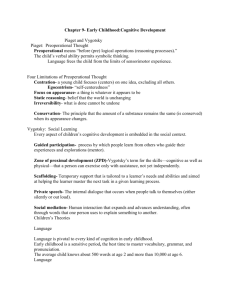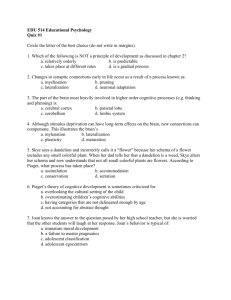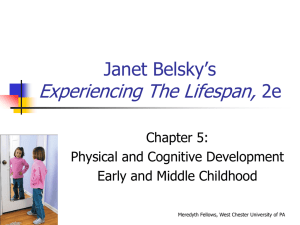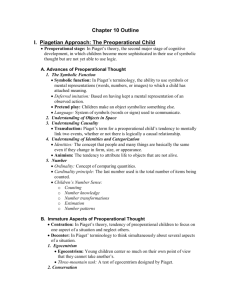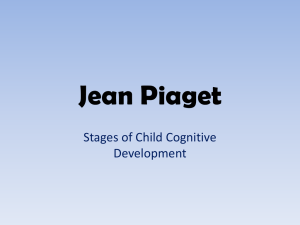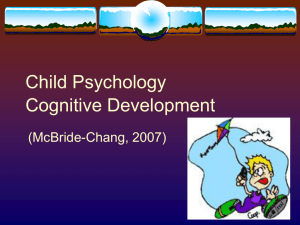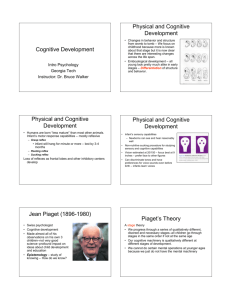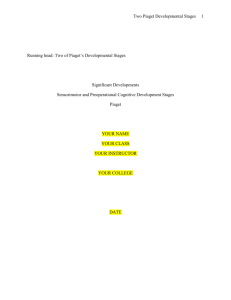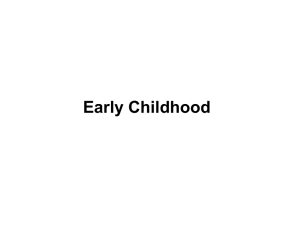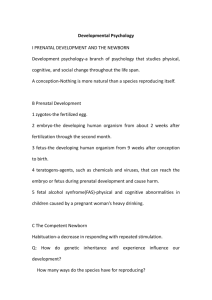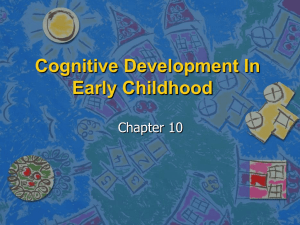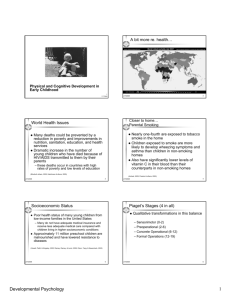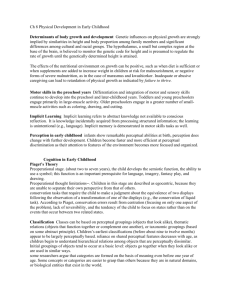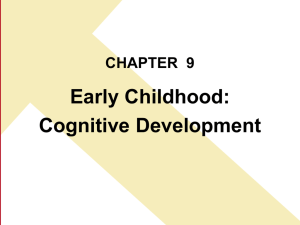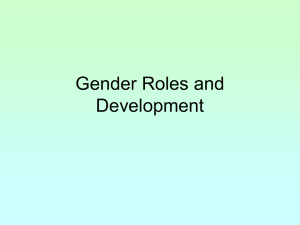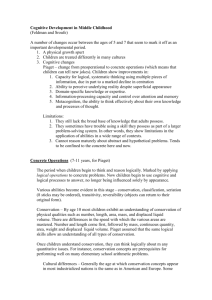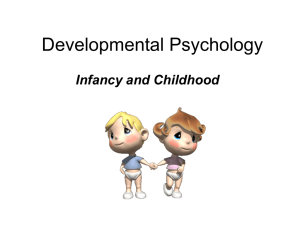Chapter 5
advertisement
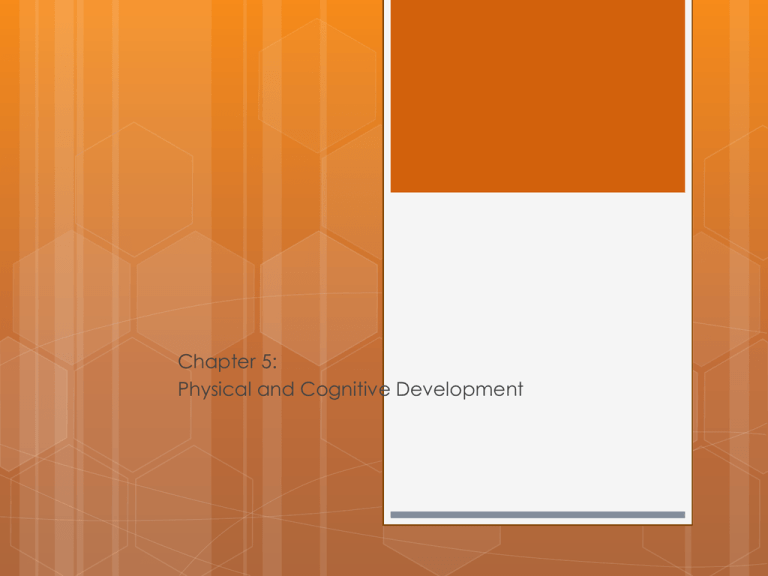
Chapter 5: Physical and Cognitive Development Setting the Context: Special Social Learning Tasks What sets us apart from other animals? Human Socialization Learn norms of our culture Ability to take another person’s perspective Mind-reading skill (begins with joint attention) Language Slow-growing Frontal Lobes Compared to other parts of the brain, frontal lobe development is on a delayed timetable. As frontal lobes mature throughout childhood and adolescence, our ability to think through, inhibit, and plan our actions gradually improves. Physical Development Cephalocaudal sequence—bodies elongate and lengthen Mass-to-specific sequence—physical abilities become more coordinated and precise Two types of physical skills Gross Motor skills: large muscle movement Fine Motor skills: small coordinated movement Threats to Growth and Motor Skills Inadequate Nutrition: top-ranking twenty-firstcentury global public health threat to physical development! Stunting Compromises bone, muscle, and brain development Causes lethargy Impairs gross and fine motor skills Cognitive Development Cognitive Development Piaget’s Preoperational Stage Spans ages 2–7 Preoperational thinking Characteristics Child has an inability to step back from his immediate perceptions and think conceptually. Thinking is qualitatively unlike that of an adult. Child cannot reason logically, and cannot look beyond appearance of objects. Young children understand only what they can see. Assessing Preoperational Thought Piaget’s Conservation Tasks Conservation: our knowledge that the amount of a given substance remains the same despite changes in its shape or form Preoperational children do not understand: The laws of conservation! The concept of reversibility! Children center only on what they can see! Preoperational Thinking Children also have trouble grasping these concepts: Class inclusion: the understanding that a general category can encompass several subordinate elements Seriation: the ability to put things in order according to some principle, such as size Preoperational Thinking: Peculiar Perceptions About People Children have an inability to grasp “identity constancy” A person’s core “self” stays the same despite changes in external appearance. Peculiar Perceptions about People Animism The belief that inanimate objects are alive Artificialism The belief that humans make everything in nature Egocentrism An inability to understand another’s perspective Piaget’s Concrete Operational Stage: Ages 8–11 Transition from preoperations to concrete operations develops gradually (5–7), but by age 8 children are firmly in this stage. Understand conservation tasks Understand identity constancy Look beyond immediate appearances Begin to understand principles of basic math Lev Vygotsky: A Different View of Cognitive Growth Human interaction promotes learning and cognitive growth. Zone of Proximal Development Scaffolding Learning is bidirectional. Tips for Effective Scaffolding First and foremost, foster a secure attachment. Break larger cognitive tasks into smaller, more manageable steps. When child makes a mistake, give nonthreatening feedback. Continue helping until child has mastered concept, then move on. Set an overall framework for the learning task and build in motivation. Cognitive Development: Information-Processing Perspective Looks at specific skills such as the development of memory, concentration, and the ability to inhibit and control our actions Mental growth occurs gradually, not in stages. Attempts to decode the “processing steps” involved in thinking Explores the development of memory and executive functions Information Processing: Making of Memory Working Memory Holds about 7 bits of information Keeps information in awareness; we either process information or discard it Executive processor: allows us to focus on important material to prepare for permanent storage Memory bin capacity expands between ages 2–7. Allows for new understanding at around 7–8 (concrete operations) Sense Information Processing: Exploring Executive Functions Executive Functions: any frontal-lobe ability that allows us to inhibit our responses and to plan and direct our thinking Rehearsal Selective Attention Inhibition Language Vygotsky Emphasized language as being front and center of everything we learn inner speech: repeating information silently or “out loud” in order to regulate behavior or to master cognitive challenges Young children speak “out loud” to monitor their behavior. Developing Speech By age 2, children begin to put together words. Phonemes: individual word sounds of language (e.g., in English, “c” sound for cat) Morphemes: language Coded by “mean length of utterance” (MLU) “Me want juice” = 3 MLU’s Syntax: the basic meaning units of System of grammatical rules in a particular language Developing Speech Semantics: understanding word meanings About 10,000 words at age 6 Vocabulary continues to grow throughout life. Overregularization Puts irregular “pasts” and “plurals” into regular form “If I walked, I also must have runned and swimmed.” Over/underextensions Applies verbal labels too broadly/narrowly Making Sense of Other’s Minds: Theory o Mind The understanding that other people have different beliefs and perspectives from one’s own Emerges about age 4–5 Typical in Western cultures Researchers use “FalseBelief” studies See illustration at right. “Mean Monkey” exercise Studies proved Piaget’s belief’s about preoperational egocentrism had flaws. #3: Where will Mrs. X look for the toy? Differences in Development of Theory of Mind? Early development of Theory of Mind Having older siblings Advanced intellectual development Bilingual preschoolers Later development of Theory of Mind Frontal lobe damage Autism “mindblindness”
